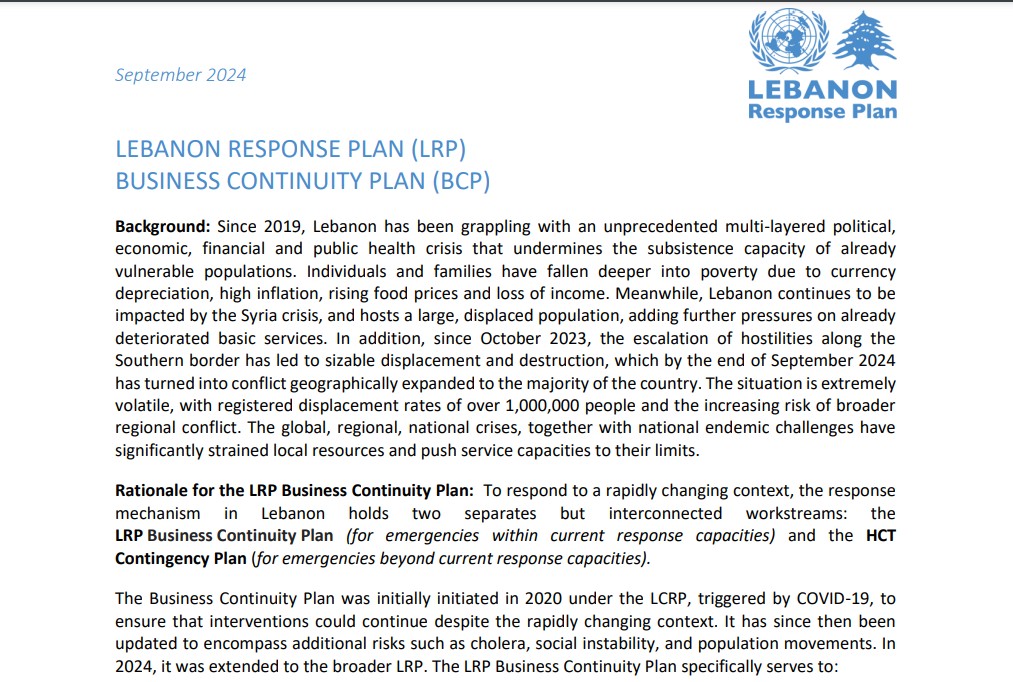Lebanon Response Plan (LRP) Business Continuity Plan (BCP)
 |
annuaire Sep 2024 ; 39 pages
Ed. IOM-Leb - OCHA - Beirut UNICEF - Beirut UNHCR - Beirut
Téléchargeable sous format: PdF
Abstract:
Since 2019, Lebanon has been grappling with an unprecedented multi-layered political,
economic, financial and public health crisis that undermines the subsistence capacity of already
vulnerable populations. Individuals and families have fallen deeper into poverty due to currency
depreciation, high inflation, rising food prices and loss of income. Meanwhile, Lebanon continues to be
impacted by the Syria crisis, and hosts a large, displaced population, adding further pressures on already
deteriorated basic services. In addition, since October 2023, the escalation of hostilities along the
Southern border has led to sizable displacement and destruction, which by the end of September 2024
has turned into conflict geographically expanded to the majority of the country. The situation is extremely
volatile, with registered displacement rates of over 1,000,000 people and the increasing risk of broader
regional conflict. The global, regional, national crises, together with national endemic challenges have
significantly strained local resources and push service capacities to their limits.
Rationale for the LRP Business Continuity Plan: To respond to a rapidly changing context, the response
mechanism in Lebanon holds two separates but interconnected workstreams: the
LRP Business Continuity Plan (for emergencies within current response capacities) and the HCT
Contingency Plan (for emergencies beyond current response capacities).
The Business Continuity Plan was initially initiated in 2020 under the LCRP, triggered by COVID-19, to
ensure that interventions could continue despite the rapidly changing context. It has since then been
updated to encompass additional risks such as cholera, social instability, and population movements. In
2024, it was extended to the broader LRP. Contents:
I. Risk Analysis, Prevention and Mitigation Measures.......................................................................3
Risk 1: Lack of containment of outbreaks and infectious diseases....................................................4
Risk 2: Sharp deterioration in protection space contributing to involuntary movements ..........8
Risk 3: Increased Social Instability.....................................................................................................15
Risk 4: Supply gaps (including wheat, fuel, electricity, and water).................................................19
Risk 5: Pressure on partners due to increasing needs ......................................................................23
Risk 6: Access Issues and Closing Operational Space ..................................................................29
Risk 7: Operational risks linked to transfer values............................................................................33
Inter-Sector preparedness measures across risks.............................................................................36
II. Emergency Preparedness and Response Coordination under the LRP ........................................37
1. Needs Assessments....................................................................................................................37
2. Contingency Stocks.....................................................................................................................38
3. Information Management .........................................................................................................38
4. Response Monitoring and Reporting.........................................................................................39
5. Remote Modalities for Provision of Services and Assistance...................................................39
Pays concerné: |
Editeurs/Diffuseurs: |
|
IOM-Leb
-
International Organization for Migration (IOM) - - Liban |
OCHA
-
Office for the Coordination of Humanitarian Affairs - Beirut - Liban |
UNICEF
-
United Nations Children's Fund - Beirut - Liban |
UNHCR
-
United Nations High Commissioner for Refugees - Beirut - Liban |
En cas de lien brisé, nous le mentionner à communication@pseau.org